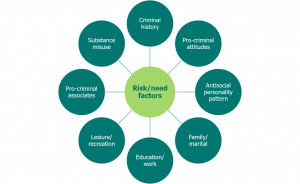Specific areas of delivery
The research literature emphasises the importance of ensuring that both needs and strengths are addressed to support service users to desist from offending. Within the Risk-Need-Responsivity (RNR) model, the needs principle states that relevant offending-related needs should be the focus of targeted interventions, rather than those which are not related to offending behaviour. A review of the current literature has identified the following ‘central eight’ risk/need factors, the final seven of which are dynamic and amenable to change:

![]() Find out more about The Risk-Need-Responsivity Model
Find out more about The Risk-Need-Responsivity Model
To assist with effective case supervision, the Offender Assessment System (OASys) was developed in 2001, building upon the existing ‘What Works’ evidence base. Within OASys, the following eight factors are now scored as criminogenic needs: accommodation; education, training, and employment (ETE); relationships; lifestyle; drugs misuse; alcohol misuse; thinking and behaviour; and attitudes. These align closely to the ‘central eight’ factors outlined above.
A number of these areas are covered in this section of the evidence resource.



